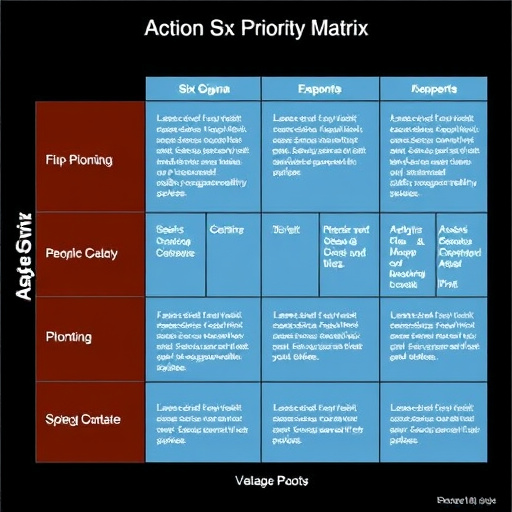The Six Sigma Action Priority Matrix is a strategic tool for efficient task management in Six Sigma projects, categorizing tasks into four quadrants based on urgency and importance. This visual framework aids project managers in prioritizing critical activities, enhancing data-driven decision-making, and promoting effective resource allocation. By distinguishing between urgent and important tasks, it streamlines decision processes, improves productivity, and contributes to the overall success of Six Sigma initiatives.
“Uncover the power of the Six Sigma Action Priority Matrix—a game-changer in project prioritization. This comprehensive guide explores a structured approach to streamline your Six Sigma initiatives. Learn how this matrix distinguishes itself from other tools, leveraging key features for efficient problem-solving. We’ll compare its effectiveness with traditional methods and provide real-world applications. Discover best practices to master the implementation process, ensuring successful outcomes in any Six Sigma project.”
- Understanding the Six Sigma Action Priority Matrix
- Key Features and Benefits of Using This Matrix
- Comparison with Other Prioritization Tools
- Practical Applications in Six Sigma Projects
- Best Practices for Effective Implementation
Understanding the Six Sigma Action Priority Matrix

The Six Sigma Action Priority Matrix is a powerful tool that helps organizations and teams prioritize actions effectively, especially within the framework of Six Sigma methodologies. It provides a structured approach to assess and rank tasks based on their urgency and importance, ensuring that resources are allocated efficiently. This matrix categorizes initiatives into four quadrants: Important and Urgent, Important but Not Urgent, Urgent but Not Important, and Not Urgent and Not Important.
Understanding this matrix involves recognizing the value of differentiating between tasks that require immediate attention and those that contribute to long-term strategic goals. By visually plotting these actions on the matrix, teams can make informed decisions about which projects to tackle first, facilitating a more focused and streamlined problem-solving process in Six Sigma projects.
Key Features and Benefits of Using This Matrix

The Six Sigma Action Priority Matrix stands out as a powerful tool for project managers and teams looking to streamline their processes and maximize efficiency within the Six Sigma framework. Its key features include a visual layout that categorizes tasks based on both urgency and importance, providing a clear picture of where to focus efforts. This matrix typically divides projects into four quadrants: immediate actions, important but not urgent, urgent but not important, and neither urgent nor important.
By prioritizing tasks in this manner, teams can avoid getting caught up in less critical activities that may appear urgent due to their immediacy. The Six Sigma Action Priority Matrix encourages a strategic approach, enabling project managers to allocate resources effectively. It fosters a culture of focused, data-driven decision-making, ultimately leading to more successful process improvements and overall operational excellence within Six Sigma initiatives.
Comparison with Other Prioritization Tools

In the realm of Six Sigma, efficient project management and task prioritization are key to achieving optimal results. The Six Sigma Action Priority Matrix stands out as a powerful tool in this regard, offering a structured approach to organizing and ranking tasks. When compared to other prioritization methods, it provides a clear and concise framework that enhances decision-making processes. Unlike more complex systems, the matrix simplifies prioritisations by categorizing tasks based on their urgency and importance, making it easily accessible for team members at all levels.
Unlike traditional lists or priority charts, the Six Sigma Action Priority Matrix encourages a strategic view of projects. It distinguishes between tasks that require immediate attention (urgent but not important) and those that are significant but can wait (not urgent but important). This differentiation fosters a more balanced approach to project management, ensuring resources are allocated effectively. As a result, teams using this matrix often experience improved productivity, better time management, and increased focus on high-value activities, ultimately contributing to successful Six Sigma initiatives.
Practical Applications in Six Sigma Projects

The Six Sigma Action Priority Matrix is a powerful tool that simplifies complex decision-making processes within Six Sigma projects. It facilitates the prioritization of tasks and initiatives by evaluating them based on their urgency and importance, effectively categorizing them into four quadrants. This strategic approach ensures that resources are allocated efficiently, focusing on high-impact activities while managing less urgent but still essential tasks.
Practical applications in Six Sigma projects include streamlining project execution, enhancing productivity, and fostering a culture of data-driven decision-making. By employing this matrix, teams can identify and tackle critical issues first, avoiding the pitfalls of task overload and ensuring every effort contributes significantly to process improvement goals.
Best Practices for Effective Implementation

When implementing the Six Sigma Action Priority Matrix, a structured approach is key to success. Begin by clearly defining objectives and desired outcomes, aligning them with the organization’s strategic goals. This ensures that all efforts are focused and directed towards measurable targets. Next, gather relevant data and insights from various stakeholders, as this information provides critical context for prioritizing actions.
Regular reviews and updates are essential best practices. The Six Sigma Action Priority Matrix should not be a static document; it must evolve with changing circumstances. Schedule periodic meetings to assess progress, re-evaluate priorities, and make adjustments as new insights emerge. This dynamic nature fosters adaptability and ensures that the matrix remains a powerful tool for driving continuous improvement within Six Sigma initiatives.
The Six Sigma Action Priority Matrix stands out as a powerful tool for project managers and teams aiming to streamline their processes. By prioritizing actions based on urgency and importance, this matrix enhances efficiency in Six Sigma initiatives. Compared to other prioritization methods, its intuitive nature and ability to clearly define high-, mid-, and low-priority tasks make it a game-changer. Practical applications across various sectors demonstrate its versatility. When effectively implemented, following best practices such as regular reviews and stakeholder involvement, the Action Priority Matrix can significantly contribute to successful Six Sigma project outcomes.
